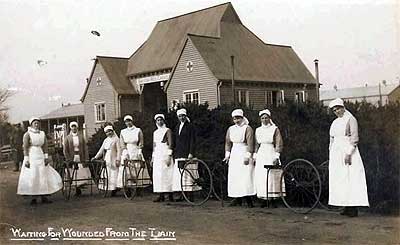Ambulance
trains were first used during the First World War in France and Belgium
to transport wounded or sick soldiers to hospital. Ambulance trains
were also called "first-aid trains", "hospital trains",
"casualty evacuation train"s or "travelling hospitals".
They were specifically designed so that nurses of the Red Cross and
the Queen Alexandra's Imperial Military Nursing Service (QAIMNS) and
army medical officer doctors and orderlies of the Royal Army Medical
Corps (RAMC) could continue the care of evacuated soldiers. As can be
seen in the drawing below, the interior of the ambulance train would
be fitted with beds down each side to maximise the number of wounded
that could be transported.
 |
A
hospital carriage being lowered to the track at Swindon |
|
These
trains, some 30 in all (some sources say 34), were assembled for the
purpose of removing wounded from urban areas to hospitals in safer parts
of Britain. Twenty of these trains were based in the London area, six
in the provinces, and a further two in Scotland. All were made up from
existing rolling stock which was modified by each railway company in
their own workshops. The GWR provided 6 of the trains which were composed
of 12 vehicles, made up of two corridor brake thirds (used for carrying
food/medical supplies and staff accommodation), and 10 stretcher vans
fitted with steam heating. These stretcher vans were mainly converted
from "Siphon G" bogie milk vans.Some of the ambulance trains
were also fitted out with an operating theatre. To ensure better hygiene
and the ability to scrub down these theatres would be completely tiled.
Emergency operations would be performed despite the movement of the
train, the cramped conditions and poor lighting.
Eventually,
one of the stretcher vans in the middle of each train was replaced with
a special staff mess/recreation van converted from a gutted centre corridor
third or restaurant car. When the time came to begin the work, the GWR
located the vehicles, effected the conversions, and moved them to their
wartime stabling positions - all within 3 days.
 |
Nurse
waiting at Netley for the arrival of hospital train patients |
|
Ambulance
trains were also used during the Second World War in England and Scotland
to transfer the wounded to the many temporary and permanent UK Military
Hospitals for further recuperation and treatment. Most of these military
hospitals were located in rural locations so that servicemen would not
suffer unduly from air raids by the German Luftwaffe. The main line
train companies actively helped the Army, Navy and RAF with supply and
conversion of the ambulance trains and during World War II this was
sanctioned by the Railway Executive Committee.
By
the time of the Second World War there were about 30 ambulance trains
in operation. Each carriage was painted with a red cross on white background
on the roof and side so that enemy planes would identify them as hospital
trains and not troop or supply trains. Under the Geneva convention this
prevented them becoming a legitimate target .
A
typical ambulance train would have 14 carriages. The first carriage
would hold the brake carriage and boiler, depending on the number of
stretcher cases there would usually be six carriages made into bedded
wards, one carriage for patients who could sit on seats and one carriage
that was a combined operating theatre, pharmacy and medical store. Two
carriages would be fitted into a cookhouse and dining room whilst two
more carriages would serve as accommodation for the medical and nursing
staff. The last carriage was the brake end and general store.
The staff carriages
were usually converted from the first class carriages and compartments
to ensure the comfort of the nursing and medical staff who would be
stationed permanently to the ambulance train.
Work was
arduous and many of the casualties came straight from the battlefield
such as the Battles of Ypres in the First World War. QAs were kept busy
preserving the lives of badly wounded soldiers until they could be evacuated
to military hospitals.
In Britain
civilian nurses worked aboard hospital trains during the evacuation
of patients from cities that were bombed by the German Luftwaffe.
Ambulance
trains were used during the Korean War in 1953 when wounded POWs were
repatriated as part of Operation Little Switch.